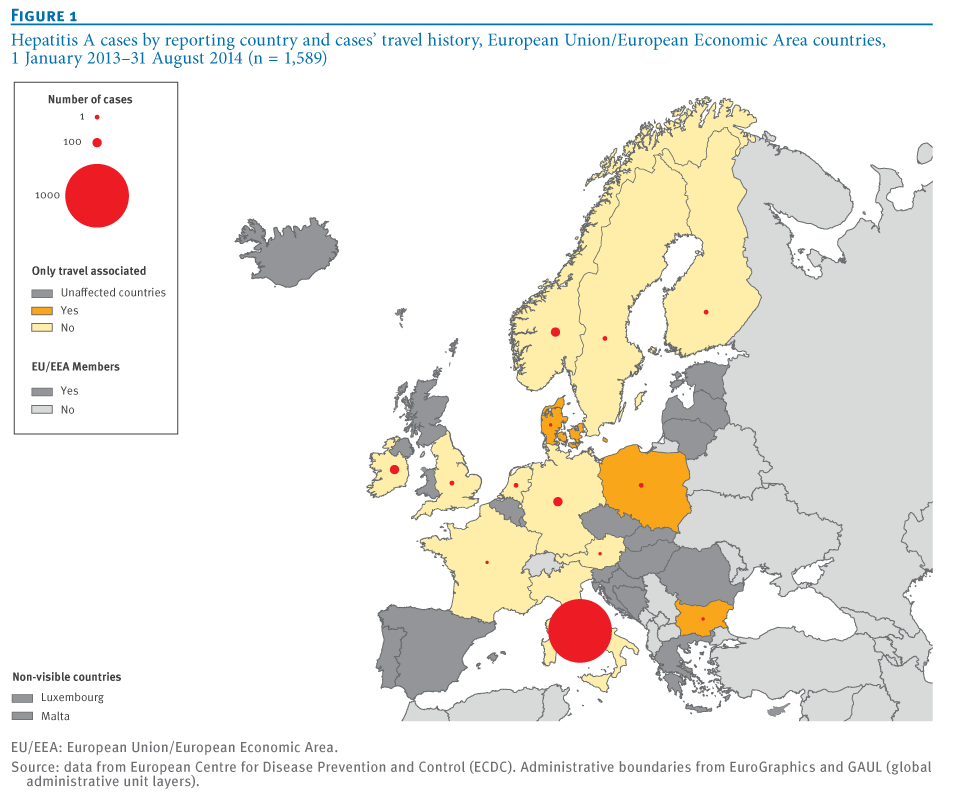Universal childhood and/or targeted vaccination of workers in the berry production chain may be considered at national level, said the authors writing in Eurosurveillance.
From January 2013 to August 2014, 1,589 hepatitis A cases were associated with a multistate outbreak; 1,102 (70%) were hospitalised for a median six days and there were two related deaths.
Most of the cases (n = 1,438; 90%) were reported in Italy. Germany, Ireland and Norway reported around 30 and all other countries had fewer, with Austria, Bulgaria and Denmark reporting a single case associated with the outbreak.
Molecular investigations identified cases infected with an identical strain of hepatitis A virus subgenotype IA.
Initial report and fallout
In May 2013, Germany reported seven cases in travellers to northern Italy through the European Commission’s Early Warning Response System (EWRS).
Following this alert, other European Union/European Economic Area (EU/EEA) countries reported cases associated with travel to Italy and the country declared a national outbreak.
Soon after the Italian national outbreak in May 2013, microbiological evidence found that frozen berries were the vehicle of Hepatitis A virus (HAV).
In Austria, Bulgaria, Germany, Italy and Poland additional information on eating berries was gathered for cases infected with the outbreak strain or reporting a travel history to Italy in or after spring 2013.
Of 788 patients with information on possible exposure 495 (63%) from 13 countries reported exposure to berries. The majority of primary cases indicated eating frozen berries, often in smoothies or cakes.

Different protocol problems
Most countries used different protocols for HAV sequencing from human samples, and for food samples a protocol specifically developed for products possibly involved was not always available.
This practice hampered strain comparison within and between human and food isolates, said the study.
Following the outbreak, a group agreed to promote the use of a standard sequencing protocol by HAV-NET for human HAV samples, and, when possible, for food.
The protocol was sent to national public health laboratories in the EU/EEA countries to help compare and exchange information on sequencing results, and speed up molecular investigations in future outbreaks.
As only some EU/EEA countries perform molecular typing, and often only on a subset of cases, it is likely additional cases were missed in countries not performing routine sequencing of isolates from hepatitis A patients.
A confirmed case reported by Ireland in August 2014 was most likely infected in Romania, a country not performing molecular characterisation of HAV isolates and not reporting cases associated with this outbreak.
However, cases reported in Italy may have been over-estimated due to enhancement of national surveillance and absence of routine sequencing.
Of 1,438 cases, 17% were diagnosed with the outbreak sequence. Some were possibly infected by other HAV strains not associated with the outbreak and independently circulating in Italy.
It is also plausible that, after such a long circulation of the outbreak strain, some confirmed cases may have been infected through a different transmission mechanism than foodborne.
It is important countries producing berries establish and monitor hygiene standards and HA awareness for berry pickers and commercial berry producers consider the risk of contamination with HAV and other viruses in Hazard Analysis of Critical Control Points (HACCP) programmes.
Enhance sensitivity of detection
The researchers said more work is needed to enhance sensitivity of detection of HAV in food samples and fresh and frozen berries, as it proves challenging due to low-level and unevenly spread contamination.
During French, Italian and Norwegian environmental investigations, HAV contamination was detected in 14 lots of frozen mixed berries and in two lots of mixed berry cakes.
The EFSA trace-back could not indicate a single point source of contamination but identified Bulgarian blackberries and Polish redcurrants as the most common ingredients in the lots of berries associated with cases.
Apart from Italy, where cases were reported over the whole outbreak period, locally infected HA cases occurred in well-defined waves over a period of one year in at least five different countries.
This was most likely due to the distribution of contaminated frozen berries at different times in different countries and shows the complexity of the frozen berry market in Europe.
Source: Eurosurveillance, Volume 20, Issue 29, 23 July 2015
“Large and prolonged foodborne multistate Hepatitis A outbreak in Europe associated with consumption of frozen berries 2013 to 2014”
Authors: E Severi, L Verhoef, L Thornton, B R Guzman-Herrador, M Faber, L Sundqvist, R Rimhanen-Finne, A M Roque-Afonso, S L Ngui, F Allerberger, A Baumann-Popczyk, L Muller, K Parmakova, V Alfonsi, L Tavoschi, H Vennema, M Fitzgerald, M Myrmel, M Gertler, J Ederth, M Kontio, C Vanbockstael, S Mandal, M Sadkowska-Todys, M E Tosti, B Schimmer, J O’Gorman, Kathrine Stene-Johansen, J J Wenzel, G Jones, K Balogun, A R Ciccaglione, L O’Connor, L Vold, J Takkinen, C Rizzo
